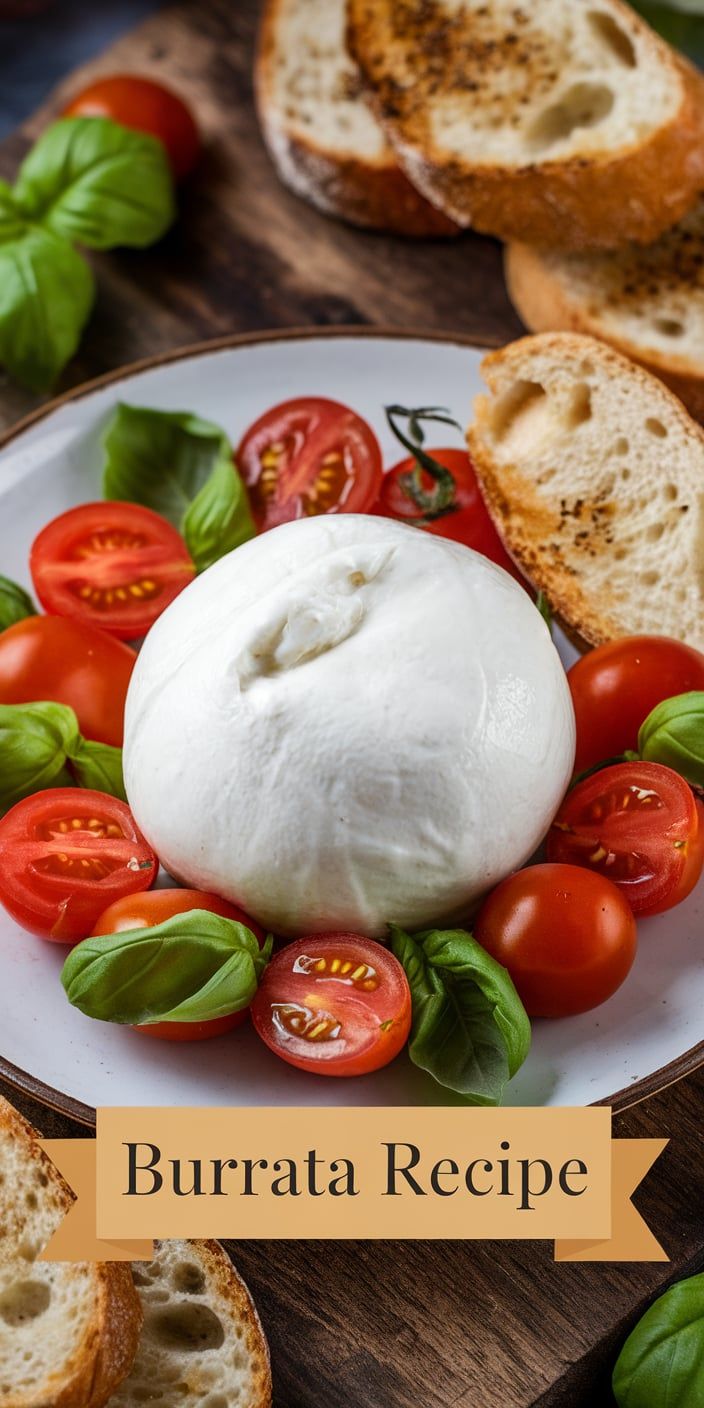Creating your own homemade burrata is an exciting culinary adventure that transforms simple ingredients into a luxurious Italian cheese recipe. I’ve discovered that making burrata from scratch isn’t just about cooking—it’s about experiencing the rich tradition of Italian cheesemaking right in your own kitchen.
This delicate cheese might seem intimidating, but with the right technique, anyone can master the art of crafting a perfect burrata. The magic happens when you combine fresh mozzarella curds with a creamy, soft center that oozes decadence with every slice.
My journey into homemade burrata has been filled with delicious experiments and delightful surprises. From understanding the intricate process to achieving that perfect stretchy texture, I’ll guide you through each step of creating an authentic Italian cheese recipe that will impress even the most discerning food lovers.
Whether you’re a cheese enthusiast or a curious home cook, this burrata recipe will unlock a world of culinary creativity. Get ready to transform simple ingredients into a gourmet experience that celebrates the rich flavors of traditional Italian cheesemaking.

What Makes Burrata Special: A Luxurious Italian Cheese
Burrata is a culinary treasure that captures the essence of artisanal cheese-making from the heart of Puglia, Italy. This extraordinary cheese represents more than just a dairy product – it’s a celebration of traditional craftsmanship and regional culinary heritage.
As a cheese enthusiast, I’ve discovered that burrata stands out from other cheeses in several remarkable ways. Let me share why this Puglia cheese is so exceptional.
The Origins of Burrata in Puglia
Burrata emerged in the early 20th century in the Murgia region of Puglia. Local farmers developed this unique cheese as a creative way to use leftover mozzarella scraps. The result was a luxurious cheese with a soft outer shell and a creamy, decadent center that revolutionized Italian cheese-making.
Understanding the Difference Between Burrata and Mozzarella
While burrata vs mozzarella might seem similar, they’re distinctly different. Mozzarella is a solid cheese, whereas burrata is a pouch of mozzarella filled with soft stracciatella cheese and cream. This filling creates a rich, indulgent experience that sets burrata apart:
- Mozzarella: Firm, stretchy texture
- Burrata: Soft outer shell with creamy interior
- Flavor profile: Burrata is more luxurious and complex
Why Homemade Burrata Tastes Better
Crafting artisanal burrata at home allows you to control quality and freshness. Store-bought versions can’t compete with the delicate texture and pure flavor of freshly made burrata. The process lets you experience the true essence of this remarkable Puglia cheese, connecting you directly to its rich culinary tradition.
Essential Ingredients for Perfect Burrata Recipe
Creating delicious burrata starts with selecting the right burrata ingredients. Fresh cheese making requires precision and high-quality components that transform simple milk into a luxurious delicacy. I’ll walk you through the essential ingredients that will help you craft an authentic Italian cheese experience right in your kitchen.
The foundation of any great burrata recipe begins with premium ingredients. You’ll need:
- Whole milk (preferably organic, with 3.5-4% fat content)
- Heavy cream for the rich filling
- Liquid rennet or vegetarian rennet
- Citric acid
- Kosher or sea salt
Fresh cheese making demands careful ingredient selection. The milk’s quality directly impacts the burrata’s texture and flavor. I recommend using fresh, non-ultra-pasteurized milk from local dairies when possible. The fat content creates that signature creamy consistency that makes burrata so irresistible.
Optional ingredients can elevate your burrata to gourmet levels. Consider adding:
- Fresh herbs like basil or chives
- Truffle salt for a luxurious twist
- Extra virgin olive oil for drizzling
Each ingredient plays a crucial role in transforming simple milk into a spectacular cheese. The combination of high-quality milk, precise measurements, and careful technique will help you master the art of fresh cheese making.
Kitchen Tools and Equipment You’ll Need
Crafting delicious burrata at home requires the right cheese making tools and burrata equipment. My journey into homemade cheese has taught me that having the proper gear makes all the difference between success and frustration.
Before diving into the cheese-making process, let me share the essential tools you’ll want to have ready in your kitchen.
Must-Have Tools for Cheese Making
- Large stainless steel pot (at least 5-quart capacity)
- Digital instant-read thermometer
- High-quality cheesecloth
- Slotted spoon
- Cheese molds or forms
- Kitchen scale for precise measurements
Optional Equipment for Better Results
While not absolutely necessary, these burrata equipment additions can elevate your cheese-making experience:
- pH testing strips
- Dedicated cheese-making pot
- Cheese mat for draining
- Sterile gloves
- Cheese press
Temperature Control Essentials
Precise temperature is crucial in cheese making. I recommend investing in a digital thermometer with accuracy within 1-2 degrees. Maintaining consistent temperatures helps create that perfect creamy burrata texture every cheese maker dreams about.
Remember, quality cheese making tools are an investment in your culinary adventures. Start with the basics and gradually expand your cheese making equipment as you become more confident in your skills.
Step-by-Step Burrata Recipe
Creating a homemade burrata tutorial requires patience and precision in the cheese making process. I’ll walk you through each critical step to craft this delicious Italian delicacy from scratch.
Before starting, ensure all your ingredients and tools are prepared. The cheese making process demands careful attention to detail and temperature control.
- Prepare Fresh Milk
- Use high-quality whole milk
- Ensure milk is at room temperature
- Avoid ultra-pasteurized milk
- Create Cheese Curds
- Add citric acid and rennet
- Allow milk to separate
- Cut curds into small pieces
- Stretch Mozzarella Base
- Heat curds to 170-180°F
- Knead until smooth and elastic
- Form into a thin sheet
- Create Burrata Filling
- Shred remaining soft curds
- Mix with heavy cream
- Season with salt
- Form Final Burrata
- Place filling in mozzarella pouch
- Seal edges carefully
- Shape into a round ball
The homemade burrata tutorial requires practice. Each attempt will improve your cheese making skills, resulting in increasingly delicious results.
| Stage | Temperature | Duration |
|---|---|---|
| Milk Preparation | 70-75°F | 15-20 minutes |
| Curd Formation | 90-95°F | 30-45 minutes |
| Stretching | 170-180°F | 5-10 minutes |
Remember that mastering the cheese making process takes time. Don’t get discouraged if your first attempts aren’t perfect!
Tips for Achieving the Perfect Creamy Center
Creating an authentic burrata requires mastering several key techniques to develop that signature burrata texture everyone loves. The creamy cheese center is what makes this Italian delicacy truly special, and I’ll share my expert tips for achieving the most luxurious results.
Crafting the perfect burrata involves precise skills that transform simple ingredients into a culinary masterpiece. The magic happens in the delicate balance between the outer mozzarella shell and the rich, soft interior.
Temperature Control Techniques
Maintaining the right temperature is crucial for developing the ideal burrata texture. I recommend:
- Keep milk and cream at a consistent 90-95°F during preparation
- Use a digital thermometer for precise temperature monitoring
- Work quickly to prevent cheese from cooling too rapidly
Stretching and Forming Methods
The technique for stretching mozzarella determines the quality of your creamy cheese center. Pay attention to these key steps:
- Stretch the mozzarella slowly and evenly
- Ensure the outer layer remains thin but strong
- Create a small pouch for the creamy filling
Filling Consistency Guidelines
Achieving the perfect creamy center requires careful preparation of the inner filling. I suggest mixing stracciatella cheese with fresh cream to create a luxurious, smooth texture that will make your burrata irresistible.
Practice and patience are key to mastering these techniques. Each batch of burrata you make will help you refine your skills and create an increasingly delectable cheese experience.
Serving Suggestions and Pairings
When it comes to serving fresh burrata, the possibilities are endless. I love exploring creative ways to showcase this luxurious cheese that truly elevates any meal. Burrata pairings can transform a simple dish into a gourmet experience that delights the senses.
My favorite classic combinations highlight the cheese’s creamy texture and delicate flavor. Here are some top serving suggestions for fresh burrata:
- Drizzle with high-quality extra virgin olive oil
- Sprinkle with sea salt and cracked black pepper
- Serve alongside ripe, juicy heirloom tomatoes
- Pair with fresh basil leaves
For a more adventurous approach to burrata pairings, I recommend experimenting with unexpected flavor combinations. Try serving fresh burrata with:
- Grilled stone fruits like peaches or nectarines
- Roasted butternut squash
- Crispy prosciutto
- Honey and crushed pistachios
Wine enthusiasts will appreciate that burrata pairs beautifully with crisp white wines or light reds. A chilled Pinot Grigio or a smooth Vermentino can complement the cheese’s rich, creamy profile perfectly.
Remember, the key to serving fresh burrata is to keep it simple and let the cheese’s natural flavors shine. Whether you’re preparing an appetizer, salad, or light meal, this versatile cheese is sure to impress your guests.
Storage and Shelf Life Guidelines
Storing fresh cheese requires careful attention to maintain its delicate texture and flavor. When it comes to homemade burrata, I recommend storing it in a sealed container with fresh water or whey to keep the cheese moist and prevent drying out. The ideal temperature for storing burrata is between 35-40°F in your refrigerator’s coldest section.
The burrata shelf life is relatively short compared to harder cheeses. Fresh homemade burrata typically stays at peak quality for 1-2 days after preparation. I suggest consuming the cheese as soon as possible to enjoy its creamy center and delicate flavor. Always check for any signs of spoilage like unusual smell, discoloration, or mold before consuming.
To maximize your cheese’s freshness, drain the burrata and wrap it carefully in plastic wrap if not serving immediately. For leftover cheese, consider incorporating it into salads, spreading on toast, or mixing into pasta dishes within 24 hours of preparation. Proper storage techniques will help you preserve the luxurious texture and rich taste of your homemade burrata.
Pro tip: Always smell and visually inspect your burrata before serving. If the cheese develops an off-putting odor or shows any signs of spoilage, it’s best to discard it to ensure food safety and prevent potential foodborne illnesses.
